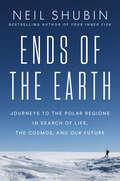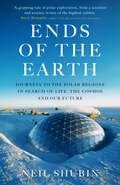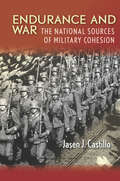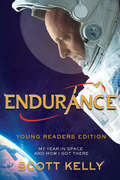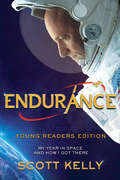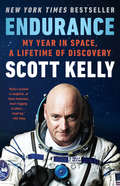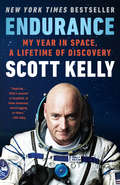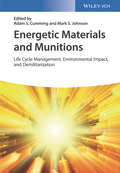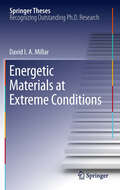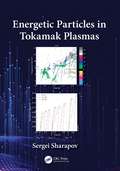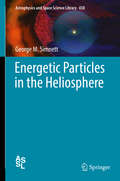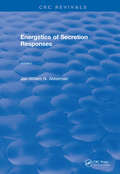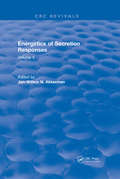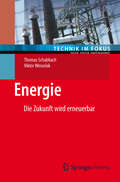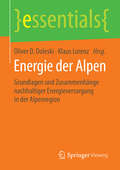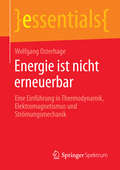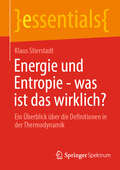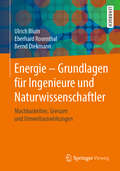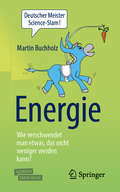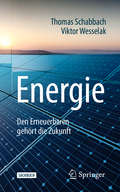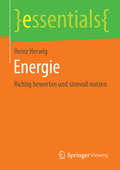- Table View
- List View
Ends of the Earth: Journeys to the Polar Regions in Search of Life, the Cosmos, and Our Future
by Neil ShubinThe bestselling author of Your Inner Fish takes readers on an epic adventure to the North and South Poles to reveal the secrets locked in the ice about life, the cosmos, and our planet&’s future. Renowned scientist Neil Shubin has made extraordinary discoveries by leading scientific expeditions to the sweeping ice landscapes of the Arctic and Antarctic. He&’s survived polar storms, traveled in temperatures that can freeze flesh in seconds, and worked hundreds of miles from the nearest humans, all to deepen our understanding of our world. Written with infectious enthusiasm and irresistible curiosity, Ends of the Earth blends travel writing, science, and history in a book brimming with surprising and wonderful discoveries. Shubin retraces his steps on a &“dinosaur dance floor,&” showing us where these beasts had populated the once tropical lands at the poles. He takes readers meteor hunting, as meteorites preserved in the ice can be older than our planet and can tell us about our galaxy&’s formation. Readers also encounter insects and fish that develop their own anti-freeze, and aquatic life in ancient lakes hidden miles under the ice that haven&’t seen the surface in centuries. It turns out that explorers and scientists have found these extreme environments as prime ground for making scientific breakthroughs across a vast range of knowledge. Shubin shares unforgettable moments from centuries of expeditions to reveal just how far scientists will go to understand polar regions. In the end, what happens at the poles does not stay in the poles—the ends of the earth offer profound stories that will forever change our view of life and the entire planet.
Ends of the Earth: Journeys to the Polar Regions in Search of Life, the Cosmos, and our Future
by Neil ShubinFrigid, remote and inhospitable – the polar regions seem far removed from our everyday lives. But these seemingly isolated ice realms shape life on our planet far more than we realise, influencing everything from the climate to ocean health. They may even hold the secrets to the origins of the Earth. Taking an epic journey of discovery from pole-to-pole, ferrying between penguins and polar bears, Ends of the Earth reveals the polar regions as never before. Meeting with the leading physicists, climatologists, geologists, biologists and palaeontologists working in these extremes – often as eccentric as they are intrepid – Neil Shubin presents the compelling new science of the Arctic and Antarctic with characteristic verve and expertise.
Endurance and War: The National Sources of Military Cohesion
by Jasen J. CastilloScholars and military practitioners alike have long sought to understand why some country's militaries fight hard when facing defeat while others collapse. In Endurance and War, Jasen Castillo presents a new unifying theory—cohesion theory—to explain why national militaries differ in their staying power. His argument builds on insights from the literatures on group solidarity in general and military effectiveness in particular, which argue that the stronger the ties binding together individuals in a group of any kind, the higher the degree of cohesion that a group will exhibit when taking collective action, including fighting in war. Specifically, he argues that two types of ties determine the cohesion, and therefore the resilience, of a nation's armed forces during war: the degree of control a regime holds over its citizens and the amount of autonomy the armed forces possess to focus on training for warfighting. Understanding why armed forces differ in their cohesion should help U.S. military planners better assess the military capabilities of potential adversaries, like Iran and North Korea. For scholars of international politics, cohesion theory can help provide insights into how countries create military power and how they win wars.
Endurance, Young Readers Edition: My Year In Space And How I Got There
by Scott KellyAn awe-inspiring memoir from NASA astronaut Scott Kelly who spent a record-breaking year in space, now newly adapted for young readers.Prepare to blast off with astronaut Scott Kelly as he takes readers on a journey through his year aboard the International Space Station and his life prior to becoming a true American hero.Discover the extreme challenges of long-term spaceflight, the pressures of living in close quarters with people from many countries, the extremely dangerous risk of colliding with space junk and the unnerving feeling of not being able to help if tragedy strikes at home. Find out the story of Kelly's childhood, his struggles in school, and ultimately the inspiration that sparked his incredible career, and the training to become a test-pilot and then astronaut.This personal and fascinating story will encourage aspiring astronauts and young readers everywhere to believe in the impossible and reach for the stars.
Endurance, Young Readers Edition: My Year in Space and How I Got There
by Scott KellyNewly adapted for young readers from the New York Times bestseller comes the awe-inspiring memoir from NASA astronaut Scott Kelly, who spent a record-breaking year in space.How does a boy struggling in school become an American hero and a space pioneer?Daredevil behavior? Check. Whether it is sailing leaky boats in the Atlantic Ocean or joining an ambulance corps to race to the rescue, living on the edge is required behavior for an astronaut.Sibling rivalry? Check. An identical twin brother who both cheers you on and eggs you on is the perfect motivator. Inspiration? Check. Finding the right book can unexpectedly change the course of your life by providing a dream and a road map for achieving it. Courage? Check. Mastering skills that could mean the difference between life and death as a fighter pilot, test pilot, and astronaut takes bravery.Endurance? Check. The grit and can-do spirit that enables you to get up every time you're knocked down and fuels the power to meet each challenge head-on and then ask, "What's next?"Scott Kelly believes, "If you can dream it, you can do it." This checklist put Scott on a rocket that launched him into space, allowed him to break a record during his inspiring year aboard the International Space Station, and showed human beings the qualities needed to go from Earth to Mars--and beyond."An engaging and high-flying read for nonfiction and space lovers alike." --School Library Journal"Those who are intrigued by space travel will find this a fascinating book." --Booklist
Endurance: A Year in Space, A Lifetime of Discovery
by Scott Kelly<P>A stunning, personal memoir from the astronaut and modern-day hero who spent a record-breaking year aboard the International Space Station—a candid account of his remarkable voyage, of the journeys that preceded it, and of his colorful and inspirational formative years. <P>The veteran of four spaceflights and the American record holder for consecutive days spent in space, Scott Kelly has experienced things very few have. Now, he takes us inside a sphere utterly hostile to human life. He describes navigating the extreme challenge of long-term spaceflight, both life-threatening and mundane: the devastating effects on the body; the isolation from everyone he loves and the comforts of Earth; the catastrophic risks of colliding with space junk; and the still more haunting threat of being unable to help should tragedy strike at home--an agonizing situation Kelly faced when, on a previous mission, his twin brother's wife, American Congresswoman Gabrielle Giffords, was shot while he still had two months in space. <P>Kelly's humanity, compassion, humor, and determination resonate throughout, as he recalls his rough-and-tumble New Jersey childhood and the youthful inspiration that sparked his astounding career, and as he makes clear his belief that Mars will be the next, ultimately challenging, step in spaceflight. <P>A natural storyteller, Kelly has a message of hope for the future that will inspire for generations to come. Here we see the triumph of the human imagination, the strength of the human will, and the infinite wonder of the galaxy. <P><b>A New York Times Bestseller</b>
Endurance: A Year in Space, a Lifetime of Discovery
by Scott Kelly<P>A stunning, personal memoir from the astronaut and modern-day hero who spent a record-breaking year aboard the International Space Station—a candid account of his remarkable voyage, of the journeys that preceded it, and of his colorful and inspirational formative years. <P>The veteran of four spaceflights and the American record holder for consecutive days spent in space, Scott Kelly has experienced things very few have. Now, he takes us inside a sphere utterly hostile to human life. He describes navigating the extreme challenge of long-term spaceflight, both life-threatening and mundane: the devastating effects on the body; the isolation from everyone he loves and the comforts of Earth; the catastrophic risks of colliding with space junk; and the still more haunting threat of being unable to help should tragedy strike at home--an agonizing situation Kelly faced when, on a previous mission, his twin brother's wife, American Congresswoman Gabrielle Giffords, was shot while he still had two months in space. <P>Kelly's humanity, compassion, humor, and determination resonate throughout, as he recalls his rough-and-tumble New Jersey childhood and the youthful inspiration that sparked his astounding career, and as he makes clear his belief that Mars will be the next, ultimately challenging, step in spaceflight. <P>A natural storyteller, Kelly has a message of hope for the future that will inspire for generations to come. Here we see the triumph of the human imagination, the strength of the human will, and the infinite wonder of the galaxy. <P><b>A New York Times Bestseller</b>
Energetic Materials and Munitions: Life Cycle Management, Environmental Impact, and Demilitarization
by Adam Stewart Cumming Mark S. JohnsonProvides a hands-on approach to demilitarization and environmental aspects of energetic materials and munitions This book gives an overview of the environmental impact of the production, use, and cleanup of energetic materials and munitions. It provides scientists, engineers, environmental specialists, and users with the understanding of environmental issues for munitions and of the ways to improve design and manage potential risks. It covers the various aspects of how chemical properties influence fate, transport, and toxicity of new formulations and prescribes tools for reducing or alleviating environmental risks. In addition, it discusses pyrotechnics and the problem of dealing with munitions underwater. Chapters in Energetic Materials and Munitions: Life Cycle Management, Environmental Impact and Demilitarization look at demilitarization in general, as well as in the future. Topics covered include logistics, costs, and management; life cycle analysis and management; and greener munitions. Another introduces readers to the "One Health" approach in the design of sustainable munition compounds. Following that, readers are taught about land assessment for munitions-related contamination in military live-fire training. The book also examines the development and integration of environmental, safety, and occupational health information. -Brings together in one source expertise and in-depth information on the current and future state of how we handle the production, use, and demilitarization of explosives and weaponry -A handy reference for experienced practitioners, as well as for training young professionals in the field -Every chapter contains real-life examples and proposes future directions for the field Energetic Materials and Munitions: Life Cycle Management, Environmental Impact and Demilitarization is an important book for explosives specialists, pyrotechnicians, materials scientists, military authorities, safety officers, health officers, and chemical engineers.
Energetic Materials at Extreme Conditions
by David I.A. MillarDavid I.A. Millar's thesis explores the effects of extreme conditions on energetic materials. His study identifies and structurally characterises new polymorphs obtained at high pressures and/or temperatures. The performance of energetic materials (pyrotechnics, propellants and explosives) can depend on a number of factors including sensitivity to detonation, detonation velocity, and chemical and thermal stability. Polymorphism and solid-state phase transitions may therefore have significant consequences for the performance and safety of energetic materials. In order to model the behaviour of these important materials effectively under operational conditions it is essential to obtain detailed structural information at a range of temperatures and pressures.
Energetic Particles in Tokamak Plasmas
by Sergei SharapovThe study of energetic particles in magnetic fusion plasmas is key to the development of next-generation "burning" plasma fusion experiments, such as the International Thermonuclear Experimental Reactor (ITER) and the Demonstration Power Station (DEMO). This book provides a comprehensive introduction and analysis of the experimental data on how fast ions behave in fusion-grade plasmas, featuring the latest ground-breaking results from world-leading machines such as the Joint European Torus (JET) and the Mega Ampere Spherical Tokamak (MAST). It also details Alfvenic instabilities, driven by energetic ions, which can cause enhanced transport of energetic ions. MHD spectroscopy of plasma via observed Alfvenic waves called "Alfvén spectroscopy" is introduced and several applications are presented. This book will be of interest to graduate students, researchers, and academics studying fusion plasma physics. Features: Provides a comprehensive overview of the field in one cohesive text, with the main physics phenomena explained qualitatively first. Authored by an authority in the field, who draws on his extensive experience of working with energetic particles in tokamak plasmas. Is suitable for extrapolating energetic particle phenomena in fusion to other plasma types, such as solar and space plasmas.
Energetic Particles in the Heliosphere
by George M. SimnettThis monograph traces the development of our understanding of how and where energetic particles are accelerated in the heliosphere and how they may reach the Earth. Detailed data sets are presented which address these topics. The bulk of the observations are from spacecraft in or near the ecliptic plane. It is timely to present this subject now that Voyager-1 has entered the true interstellar medium. Since it seems unlikely that there will be a follow-on to the Voyager programme any time soon, the data we already have regarding the outer heliosphere are not going to be enhanced for at least 40 years.
Energetics of Secretion Responses: Volume I (CRC Press Revivals)
by J.W.N. AkkermanProvides a multidisciplinary approach to the study of energetics of secretion responses by combining the knowledge and expertise of leading authorities from various fields.
Energetics of Secretion Responses: Volume II (CRC Press Revivals)
by Jan-Willem N. AkkermanProvides a multidisciplinary approach to the study of energetics of secretion responses by combining the knowledge and expertise of leading authorities from various fields.
Energie
by Viktor Wesselak Thomas SchabbachUnser heutiges Energiesystem befindet sich in der Krise: Der wachsende Verbrauch natürlicher Ressourcen stößt an seine objektive Grenze. In dieser kompakten Darstellung werden die technischen, ökologischen und gesellschaftlichen Herausforderungen an ein zukunftsfähiges Energiesystem herausgearbeitet und gut lesbar vermittelt. Mit diesem Band aus der Reihe "Technik im Fokus" finden Leser einen leichten Einstieg in die Thematik, eine tiefgehendere Diskussion von System- und auch Technologiefragen bieten weitere Bände derselben Reihe.
Energie aus Biomasse - ein ethisches Diskussionsmodell
by Michael Zichy Christian Dürnberger Beate Formowitz Anne UhlEnergie aus Biomasse wird auf politischer, wissenschaftlicher und gesellschaftlicher Ebene höchst kontrovers diskutiert. – Dieses Buch liefert eine fundierte, klare und gut verständliche Analyse und Diskussion der ethischen und kulturell-emotionalen Aspekte von Energie aus Biomasse. Es diskutiert die Frage der Verantwortung und bringt naturwissenschaftliche und ethische Expertise in einen fruchtbaren Dialog. Vergleichende Fallstudien und Szenarien sorgen für die praktische Anbindung an die derzeitige landwirtschaftliche Praxis. Die zweite, überarbeitete Auflage bezieht sich auf die aktuellen gesetzlichen Rahmenbedingungen und berücksichtig die neuesten wissenschaftlichen Beiträge zum Diskurs, wie zum Beispiel zu indirekten Landnutzungsänderungen.
Energie der Alpen: Grundlagen und Zusammenhänge nachhaltiger Energieversorgung in der Alpenregion (essentials)
by Oliver D. Doleski Klaus LorenzAls einzigartiger Natur- und Kulturraum ist die Alpenregion von landschaftsverändernden Eingriffen der Energiewirtschaft besonders betroffen und daher lautet die Kernfrage des Autorenteams um Oliver D. Doleski und Klaus Lorenz, kann bzw. wie soll der Alpenraum perspektivisch zu einer europäischen Energiekonzeption beitragen, ohne den Lebensraum Alpen zu gefährden. Die Autoren schneiden dabei komprimiert neben energiewirtschaftlichen Grundlagen Fragen der nachhaltigen Versorgung moderner Gesellschaften mit Strom und Wärme, des Erhalts weitgehend unerschlossener Räume, die Rolle wesentlicher Akteure, die Partizipation der Bürgerschaft und Facetten der Netzwerkbildung ebenso wie gesellschaftspolitische, soziologische oder historische Einflussfaktoren an.
Energie ist nicht erneuerbar: Eine Einführung in Thermodynamik, Elektromagnetismus und Strömungsmechanik (essentials)
by Wolfgang OsterhageWolfgang Osterhage stellt die für eine praktische Energiegewinnung erforderlichen Kenntnisse der Strömungsmechanik und des Elektromagnetismus vor. Er baut seine Grundlagenüberlegungen auf den beiden Hauptsätzen der Thermodynamik auf, die besagen: Es kann an Energie nichts hinzugefügt und nichts hinweg genommen werden. Und: Wir verlieren bei jeder Umwandlung nutzbare Energie. Der Autor behandelt zudem Energiebilanzen, die Konzepte von Anergie und Exergie sowie die Rolle der Entropie in physikalischen Prozessen.
Energie und Entropie - was ist das wirklich?: Ein Überblick über die Definitionen in der Thermodynamik (essentials)
by Klaus StierstadtDieses essential beschreibt zwei der wichtigsten physikalischen Begriffe, die Energie und die Entropie. Die innere und die äußere Energie von Materie und Feldern wird definiert und an Beispielen erläutert. Die Energie kann in vielerlei Formen existieren, die zum Teil ineinander umgewandelt werden können. Ob das möglich ist oder nicht, das beschreiben der Zweite Hauptsatz der Thermodynamik und die Entropie. Diese kann auf zweierlei Weise definiert werden, auf thermodynamischer und auf statistischer Grundlage. Der weitgehend geheimnisvolle Begriff der Entropie wird erläutert und seine Missdeutungen werden beschrieben.
Energie – Grundlagen für Ingenieure und Naturwissenschaftler: Machbarkeiten, Grenzen und Umweltauswirkungen
by Ulrich Blum Bernd Diekmann Eberhard RosenthalDie Grundlagen der Energietechnik erklärt von Physikern für Nicht-Physiker.Didaktisch aufbereitet präsentieren die Autoren des Buches die allgemeinen Grundlagen sowie die Erklärungen zu den wichtigsten Technologien zur Versorgung mit elektrischer Energie. Die Risiken aus der Wandlung zu elektrischer Energie und die möglichen Umweltbelastungen werden aus Sicht naturgesetzlicher Gegebenheiten analysiert und diskutiert.
Energie – Wie verschwendet man etwas, das nicht weniger werden kann?
by Martin BuchholzSie lesen täglich etwas über Energieproduktion, Energiewende, erneuerbare Energien und Energieverschwendung - aber wissen Sie überhaupt, was genau das eigentlich ist - Energie? In diesem Buch erklärt Martin Buchholz gut verständlich und in lockerem Stil diesen ganz grundlegenden Begriff der Thermodynamik.Dieses Buch zeigt auf, welche Missverständnisse in unseren Köpfen existieren. Es richtet sich somit an alle, die nie richtig verstanden haben, warum man Wärme und Strom zwar beide in Kilowattstunden messen kann, aber Wärme trotzdem weniger wert ist. Warum noch niemand ein Perpetuum mobile erfunden hat. Was eigentlich die Entropie mit allem zu tun hat. Und warum man „Energie sparen“ soll, obwohl es doch eine Größe ist, die laut Physikbuch nicht mehr und nicht weniger werden kann. Außerdem spricht es die an, die bei der Diskussion über Herausforderungen der Energiewende und der Angst vor einem Black-Out mitreden wollen.
Energie, Entropie, Kreativität: Was das Wirtschaftswachstum treibt und bremst
by Reiner Kümmel Dietmar Lindenberger Niko PaechDieses Buch hilft dabei, die Bedeutung der Thermodynamik für Wirtschaft, Umwelt und Gesellschaft zu verstehen. Es plädiert für die Integration der ersten beiden Hauptsätze der Thermodynamik in die Lehrbuchökonomie. Dabei führen systemische Gemeinsamkeiten in der Thermodynamik und in der Theorie des Wirtschaftswachstums zur Verwendung ähnlicher mathematischer Methoden, die es erlauben, industrielle Volkswirtschaften realitätsnah zu beschreiben. Davon ausgehend schlagen die Autoren Instrumente zur Lösung der Sozial- und Umweltprobleme vor.Das Buch richtet sich an alle, die sich für interdisziplinäre Forschung zu den Entwicklungsproblemen von Wirtschaft und Gesellschaft interessieren und verstehen wollen, was deren Umbrüche treibt. Mit diesen Entwicklungsproblemen beschäftigen sich seit langem die Autoren des Buches: der theoretische Physiker Reiner Kümmel von der Universität Würzburg, der Physiker und Ökonom Dietmar Lindenberger von der Universität Köln und dem Energiewirtschaftlichen Institut an dieser Universität und der Ökonom Niko Paech von der Universität Siegen.“Es ist mir ein Vergnügen, den Lesern dieses Buch zu empfehlen. Es wird von der Idee getrieben, die physikalischen Grenzen menschlichen Wirtschaftens mithilfe der Thermodynamik auszuloten, einer der universellsten physikalischen Theorien, die wir haben.“Dieter Meschede, Professor für Physik, Universität Bonn
Energie- und Produktionswende im ländlichen Raum
by Bernhard Adler Martin Dykstra Michael WintersteinVorliegendes Buch möchte Experten verschiedener Wissensdisziplinen ansprechen, vor allem Agrartechniker, Energetiker und Recyclingspezialisten. Es geht darum, die Vorteile einer zukünftigen Agrar-Energiegesellschaft zur Bewältigung der Energiewende darzulegen. Von diesem Strukturwandel ist im Grunde die gesamte Zivilgesellschaft betroffen, letztlich jeder einzelne Bürger als Konsument. Deshalb versuchen die Autoren in allgemeinverständlicher Form den Energiewandel als eine Einheit von neuen Technologien und sinnvoller Energieeinsparungen darzustellen. Mit dem Agrar-Energie-Komplex propagieren sie ein Wirtschaftsmodell, das Landwirten zukünftig eine gesicherte Existenz bilden kann.
Energie: Den Erneuerbaren gehört die Zukunft (Technik im Fokus)
by Viktor Wesselak Thomas SchabbachUnser heutiges Energiesystem befindet sich in der Krise: Der wachsende Verbrauch natürlicher Ressourcen stößt an seine objektive Grenze. In dieser kompakten Darstellung werden die technischen, ökologischen und gesellschaftlichen Herausforderungen an ein zukunftsfähiges Energiesystem herausgearbeitet und gut lesbar vermittelt. Mit diesem Band aus der Reihe „Technik im Fokus“ finden Leser einen leichten Einstieg in die Thematik, eine tiefgehendere Diskussion von System- und auch Technologiefragen bieten weitere Bände derselben Reihe.
Energie: Richtig bewerten und sinnvoll nutzen (essentials)
by Heinz HerwigHeinz Herwigvermittelt eine klare Vorstellung davon, was Energie aus physikalischer Sichtist und in welchen Formen sie auftreten kann. Es werden grundlegendemechanische, vor allem aber auch thermodynamische Zusammenhänge erläutert,bevor an konkreten Beispielen (Wärmeübergang, GuD-Kraftwerke, Wärmepumpen)gezeigt wird, wie mit Energie verantwortlich umgegangen werden kann, wieEnergie richtig bewertet und sinnvoll genutzt werden sollte. Im Zuge dieserErläuterungen wird der Exergie-Begriff eingeführt und ausführlich behandelt. Mit diesem Begriff kann die Qualität von Energie sehr anschaulich dargestelltwerden.
